Are you trying to make a more ethical and environmentally friendly choice by buying a vegan bag? It can be frustrating to discover that the "vegan" label doesn’t automatically mean "eco-friendly." Many are just made of plastic, leaving you to wonder if you’re truly helping the planet. I’m here to help clear up the confusion and show you how to identify a genuinely sustainable option.
Yes, vegan bags can be eco-friendly, but this depends entirely on the material they are made from. To make a truly positive impact, choose bags made from plant-based or recycled materials like cork, pineapple leaf fiber (Piñatex), or recycled plastics (rPET). These have a much lower environmental footprint than traditional leather. However, you should be wary of vegan leathers made from virgin plastics like PVC, which rely on fossil fuels and create harmful pollution.
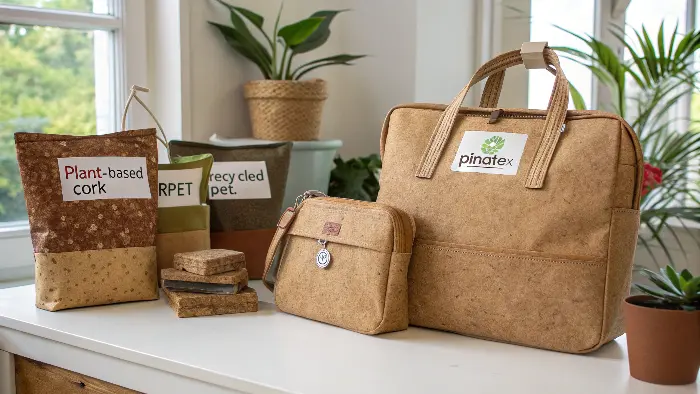
Now you know that the material is the most crucial factor. But this goes beyond simply avoiding animal products; it’s about committing to an entire lifecycle that respects our planet. The details behind what makes a material truly sustainable can be complex, but understanding them is what separates a well-intentioned purchase from a genuinely impactful one. Let’s dig deeper into what sustainability really means for the accessories you choose.
Are vegan bags sustainable?
You’ve heard "eco-friendly" and "sustainable" used to describe the same products, and it can be confusing. You might buy a bag made from a "green" material, but is it built to last or will it just end up in a landfill next year? This cycle of replacing items defeats the purpose. Let’s clarify the difference so you can find a bag that is both kind to the planet and durable for the long haul.
A vegan bag’s sustainability is judged by its entire lifecycle—from how its materials are sourced to how it’s disposed of. While it avoids the significant environmental impact of animal farming, its true sustainability depends on durability and end-of-life options. Plant-based and recycled materials often score highest because they use fewer resources and can be recycled or composted. A truly sustainable bag is one that minimizes its impact at every stage.
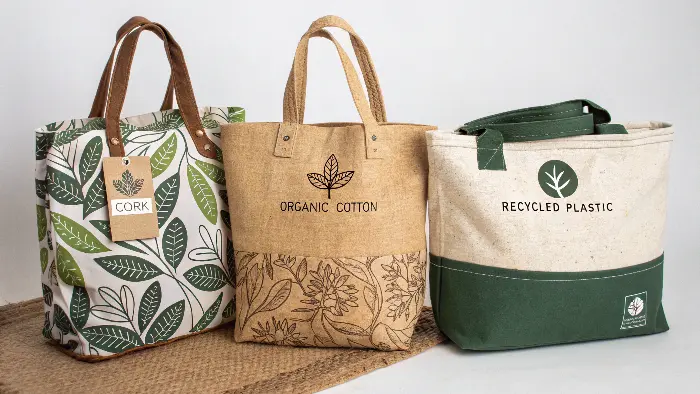
The Full Picture: A Bag’s Lifecycle
When I first started sourcing eco-friendly products for my clients, I quickly learned that "eco-friendly" can sometimes be a narrow term. It might refer to one positive aspect, like being non-toxic. Sustainability, however, is the bigger, more important picture. It considers the entire journey of a product, which can be broken down into four main stages:
- Raw Material Sourcing: Where did the materials come from? Were they grown on a renewable farm, extracted from the earth like fossil fuels, or diverted from a landfill?
- Manufacturing: How much water and energy were used to make the bag? What chemicals, if any, were involved in the process?
- Use Phase: How long will the bag last? Is it durable enough for daily use over several years?
- End-of-Life: What happens when you’re done with it? Can it be composted, recycled, or will it sit in a landfill for centuries?
Durability: The Unsung Hero of Sustainability
The most sustainable product is often the one you don’t have to replace. This is where some vegan bags fall short. A cheap bag made from thin PVC might crack and peel within a year, creating more waste. Traditional leather is known for its longevity, but modern, high-quality vegan materials are catching up. Materials like cork, high-grade polyurethane (PU), and innovative plant-based composites are now designed for excellent durability, offering a long lifespan without the environmental cost of leather tanning. Choosing a well-constructed bag from a durable vegan material is one of the best ways to ensure your purchase is truly sustainable.
Is vegan leather environmentally friendly?
"Vegan leather" sounds like the perfect answer, doesn’t it? It promises a leather-like look and feel without harming any animals. But then you hear it’s mostly just plastic, which feels like a classic case of greenwashing. It can be incredibly frustrating to feel like you’re trading one environmental problem for another. The good news is that not all vegan leathers are created equal, and I’ll break down the differences for you.
The environmental impact of vegan leather varies dramatically by type. Polyvinyl chloride (PVC) is one of the worst options, releasing harmful toxins during its lifecycle. Polyurethane (PU) is a less harmful plastic-based alternative. However, the most eco-friendly vegan leathers are plant-based, made from renewable resources like pineapple leaves, mushrooms, apples, or cork. These leverage waste streams and natural materials, making them a far superior choice for the planet.
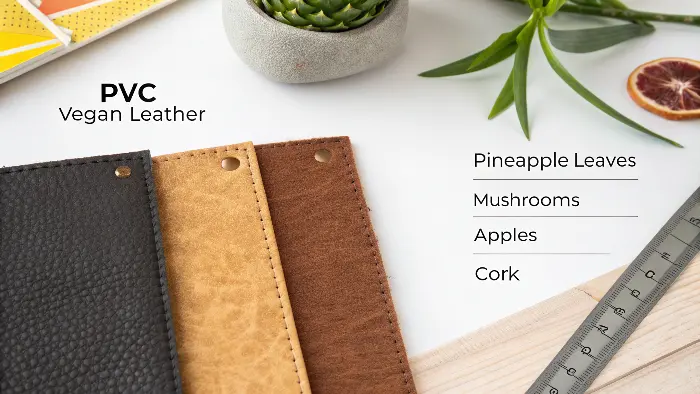
The Problem with PVC
I make it a policy at Ecosourcecn to avoid PVC (Polyvinyl Chloride) whenever possible. Although it’s cheap and durable, its environmental costs are just too high. It’s a chlorinated plastic, and its production process creates dioxins—highly toxic pollutants that build up in the food chain and can cause serious health problems. At the end of its life, PVC is not biodegradable and releases harmful chemicals whether it’s landfilled or incinerated. For these reasons, I tell my clients that if they see "vinyl" or "PVC" on a label, it’s best to look for another option.
A Better Plastic: Polyurethane (PU)
Polyurethane (PU) is another common plastic-based leather alternative. While it’s still derived from fossil fuels, it’s a significant improvement over PVC. The manufacturing process is cleaner and doesn’t create the same toxic dioxins. PU leather is also softer, more flexible, and more breathable than PVC, giving it a feel that’s closer to real leather. However, it’s still a plastic that won’t biodegrade. It’s a step in the right direction, but there are even better choices available.
The Rise of Plant-Based Leathers
This is where things get exciting. The most eco-friendly vegan leathers are made from plants and agricultural byproducts. These materials turn waste into a valuable resource.
| Material Type | Primary Source | Key Benefits | Key Drawbacks |
|---|---|---|---|
| PVC Leather | Fossil Fuels (Chlorine) | Inexpensive, water-resistant | Highly toxic production, non-biodegradable |
| PU Leather | Fossil Fuels | Softer than PVC, less toxic to produce | Still plastic, non-biodegradable |
| Plant-Based | Pineapple leaves, apples, cork | Renewable, often biodegradable, lower footprint | Can be more expensive, durability can vary |
Think about materials like Piñatex, made from pineapple leaf fibers that would otherwise be burned. Or consider apple leather, made from the pulp and skins left over from the juice industry. These innovative materials are not only vegan but are part of a circular economy, reducing waste and our reliance on fossil fuels.
What is the most eco-friendly bag material?
So, you’re ready to invest in a new bag and want to make the absolute best choice for the environment. The number of options can feel overwhelming. Cork, organic cotton, recycled plastic, hemp… they all claim to be the greenest choice. How do you possibly compare them without getting stuck in "analysis paralysis" or, even worse, accidentally picking a less-than-ideal option? Let’s create some clarity by ranking the best materials and explaining their benefits.
The most eco-friendly bag materials are typically renewable, biodegradable, and require minimal processing. Cork is a top contender because it is harvested from tree bark without harming the tree itself. Other excellent choices include organic cotton and hemp, innovative materials from agricultural waste like Piñatex, and recycled materials like rPET, which diverts plastic bottle waste from landfills and gives it a new purpose.
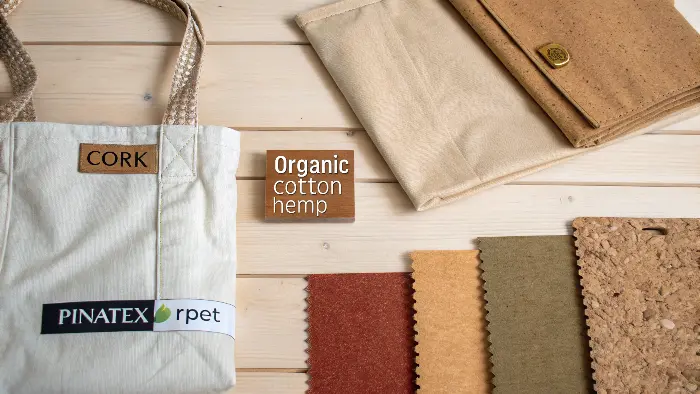
Champion of Renewables: Cork
If I had to pick one star player, it would be cork. It’s a remarkable material sourced from the bark of the Cork Oak tree. The harvesting process is regenerative; stripping the bark doesn’t harm the tree and actually encourages it to absorb more CO2 from the atmosphere. A single tree can be harvested every nine years for its entire lifespan of over 200 years. Cork is naturally lightweight, waterproof, durable, and fully biodegradable. It’s a perfect example of a material that works in harmony with nature.
From Waste to Wear: Recycled & Upcycled Materials
One of the key principles of sustainability is reducing waste. That’s why recycled materials are such a fantastic option. When I work with businesses like Jacky’s, who need sustainable packaging solutions, we often discuss recycled options first. For bags, this often means using rPET, a fabric made from recycled plastic bottles. Every bag made from rPET means fewer bottles clogging our oceans and landfills. Similarly, using recycled cotton or canvas reduces the immense water and pesticide usage associated with growing virgin cotton. These materials prove that waste isn’t waste until we waste it.
Natural Fibers: The Tried-and-True Option
We can’t forget about classic natural fibers. Organic cotton and hemp are both excellent, breathable, and strong materials for bags, especially totes and casual styles. The key here is the "organic" certification. Conventional cotton is a notoriously thirsty crop that relies heavily on pesticides. Organic farming eliminates these harmful chemicals, protecting water supplies and soil health. Hemp is even better—it grows incredibly fast with very little water and naturally suppresses weeds, eliminating the need for herbicides. Both are biodegradable, returning to the earth once their useful life is over.
Are vegan products eco-friendly?
You’ve learned a lot about bags, but this thinking applies to the entire "vegan" product world. Is a vegan label a trustworthy shortcut for an environmentally conscious purchase? It’s easy to feel let down when you realize a vegan product might still be full of synthetic chemicals or produced in-house. It makes you question if the label holds any real meaning for a sustainable buyer. Let’s zoom out and see how we can apply these principles to all vegan products.
The "vegan" label on any product simply confirms it has no animal-derived ingredients; it is not a certification of eco-friendliness. A vegan product can still be unsustainable if it’s made from virgin plastics, involves unethical labor, or uses harmful chemicals. To know if a vegan product is truly eco-friendly, you must look deeper into its material source, production process, packaging, and end-of-life plan.
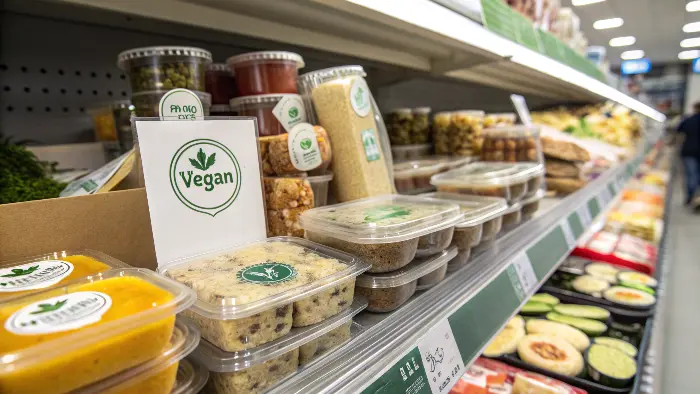
Beyond The Label: Critical Questions to Ask
The term "vegan" addresses an ethical concern about animal welfare. "Eco-friendly" addresses an environmental concern about the planet. Sometimes they overlap, but not always. When I’m vetting a new product or supplier for Ecosourcecn, I go beyond the marketing claims. I teach my B2B clients, like packaging specialist Jacky, to do the same. Here are the critical questions you should always ask:
- Material Origin: What is this made of? Is it a renewable resource (like cork or hemp), a recycled material (like rPET), or a virgin fossil fuel product (like PVC)?
- Production Impact: How was this made? Does the process consume massive amounts of water or energy? Does it release pollutants?
- Packaging: Is the eco-friendly product wrapped in layers of single-use plastic? The sustainability of a product must include its packaging.
- End-of-Life: What happens to this product when it breaks or wears out? Is it designed to be composted (like our bagasse tableware) or recycled (like FSC-certified paper)?
The Importance of Certifications
Since labels can be confusing, third-party certifications are your best friend. They provide objective verification that a product meets specific standards. For a buyer like Jacky, these are non-negotiable. Look for marks like:
- FSC (Forest Stewardship Council): Ensures paper and wood products come from responsibly managed forests.
- GOTS (Global Organic Textile Standard): The leading standard for organic fibers.
- EN 13432 / ASTM D6400: Certifies that a product is compostable in industrial facilities.
- B Corp Certification: Verifies that a business meets high standards of social and environmental performance, transparency, and accountability.
These certifications do the homework for you, providing confidence that your purchase aligns with your values.
Conclusion
Ultimately, choosing a vegan bag can be a fantastic eco-friendly decision, but it requires looking beyond the simple "vegan" label. Prioritize materials that are plant-based, recycled, and renewable, like cork or organic cotton, while avoiding virgin plastics. True sustainability is about considering the entire lifecycle—from creation to disposal—to ensure your choice genuinely supports a healthier planet.


